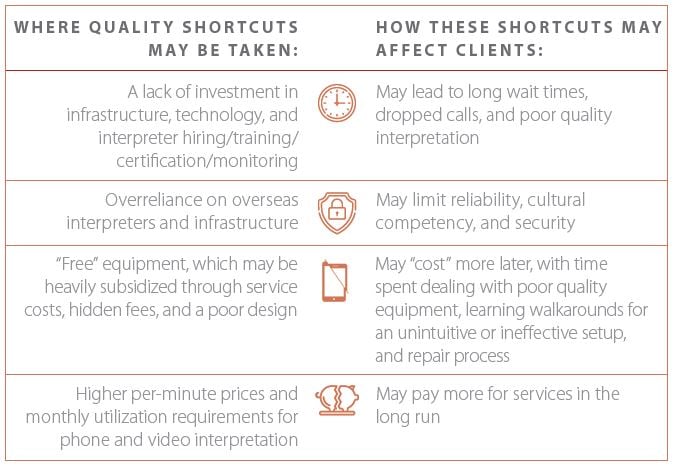
Businesses and government agencies in the market for remote interpretation services can and should take per-minute price into consideration. Budgets are often tight, and savings on one line item can help offset others.
The trouble starts when the procurement team decides to shop on price alone. Anticipated savings from a low, per-minute cost may never materialize if the total cost of ownership for the service is higher than expected.
In our new whitepaper, The Remote Interpretation Industry: Standards and Best Practices, Voiance explores quality metrics for language services providers, including offering fair pricing:
Standard: Fair and Transparent Pricing and Offerings
Some interpretation providers may over-promise on what they can actually deliver, especially if they are a small company trying to compete with major players in the industry. This may include an unrealistic combination of low prices, free high-quality equipment, the amount of languages they offer, and/or high quality interpretation.
The reality is that these promises are either not delivered as expected or the provider may cut corners for quality elsewhere.

Fair and Transparent Pricing for Specific Services and Features
Bids from providers should include a straightforward, per-minute price for services, as well as equipment options and any additional services needed to access the services. These may include software, toll-free numbers, a dedicated account manager, client services representatives or operators, implementation support, support materials, and reporting. If the provider does not make it clear that those are included in their quote, you may be charged separately for each of these features and services.
Provision of Services through Their Own Interpreters, Rather Than an Overreliance on Reselling
The Language Services Industry 2018 Market by Common Sense Advisory (CSA) explains that some interpretation providers resell services from smaller language service providers, marking up prices in the process.
CSA found that an average of 25% of their respondents’ sales were to other language services providers. These smaller companies may not have the same standards of hiring, training, and quality monitoring that the larger reseller promised.
Red Flags
- Promises that seem too good to be true, especially from a small and/or young provider
- A bid that does not include equipment, software, reporting capabilities, implementation support, or an account manager
- An interpretation “provider” that is actually a well-marketed middle man, marking up and reselling services from other providers
Download Voiance’s Industry Standards whitepaper for remote interpretation to learn more about what to look for in a language services provider.

